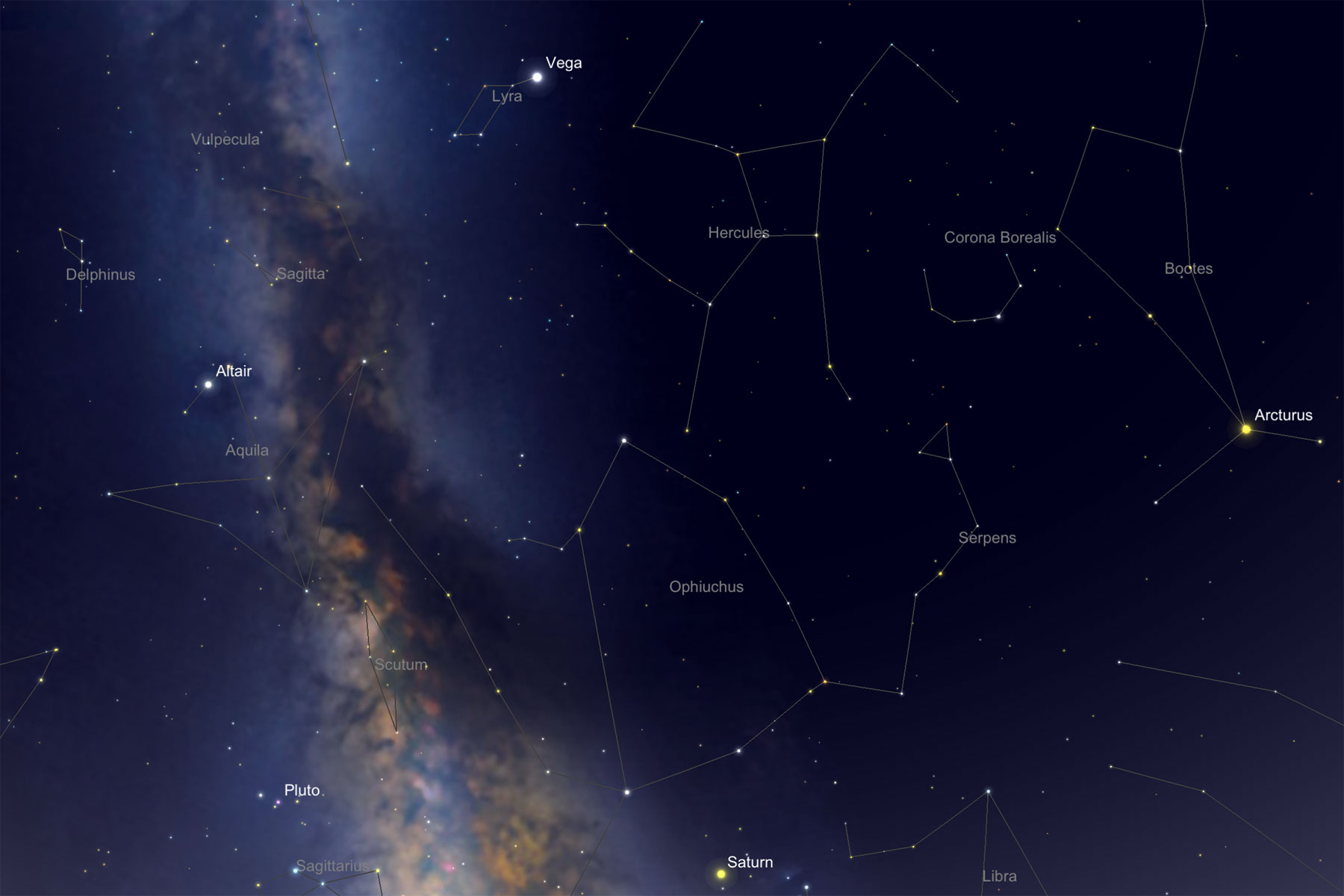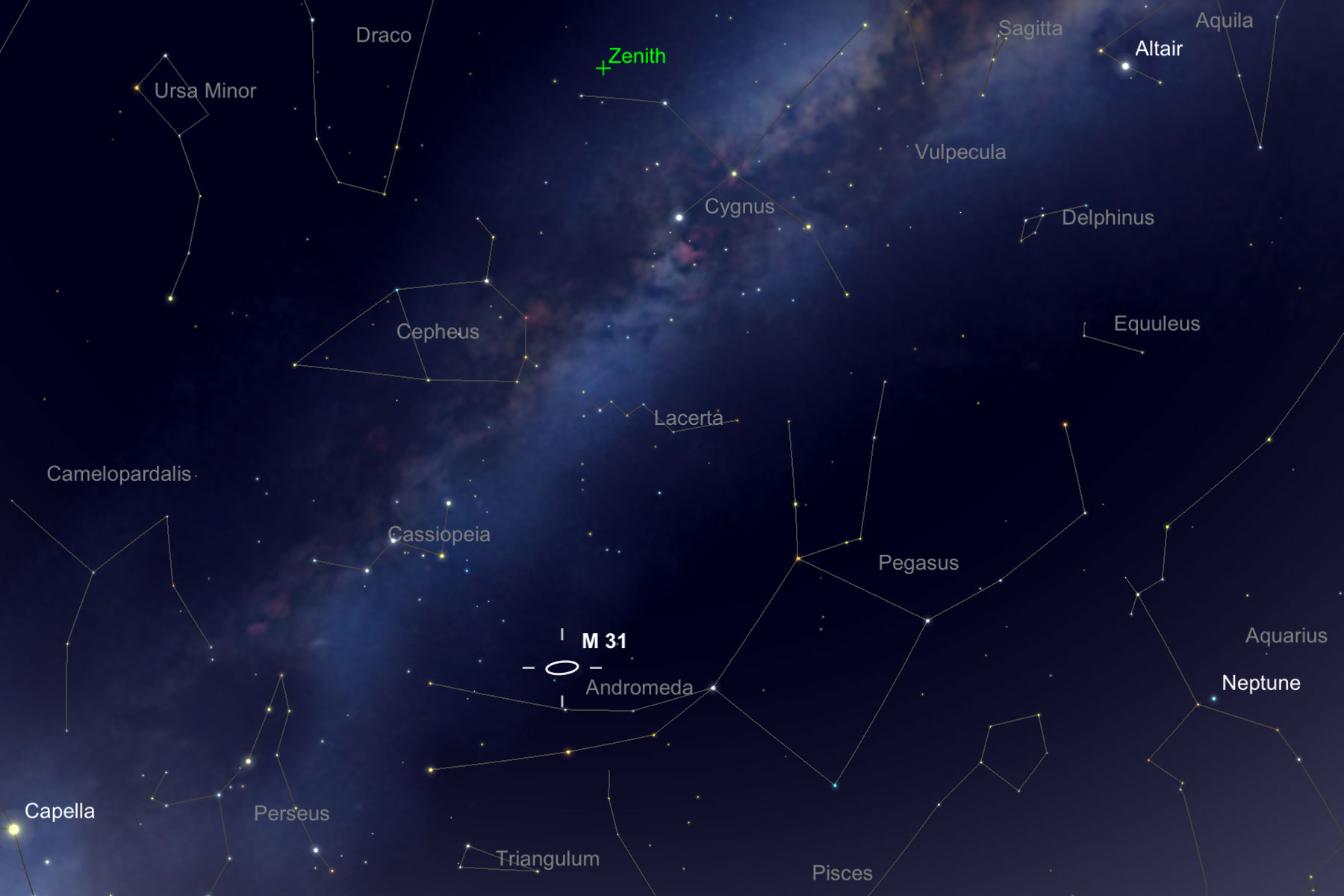Deep Sky Summer/Autumn Observations September 2017
Conditions | Observation Overview | List of Observed Sky Objects | References
In September 2017, I did simple "deep-sky summer / autumn observations", which might be of interest to other beginners and are therefore described here. They took place in Sumène, Haute Loire, France, and were carried out with my 10 x 25 binoculars and my Sky-Watcher Heritage 100 Dobsonian telescope, that is, with simple means.
Conditions
Sky Region and Objects
I confined my observations to the sky area in the south with Hercules, Cygnus, Lyra on the one hand, and to the area between Andromeda, Cassiopeia, and Perseus on the other hand, as well as Pegasus in between, and Ursa Major in the North.
Overview Map
The following map shows approximately the sky area that I primarily browsed during my observations:
Click the map for a larger version - it opens in a new window (Image Courtesy of SkySafari Astronomy, www.simulationcurriculum.com)
And here is the section of the sky in the East with Cassiopeia, Perseus, Andromeda, Pegasus a.s.o.:
Click the map for a larger version - it opens in a new window (Image Courtesy of SkySafari Astronomy, www.simulationcurriculum.com)
Observation Time
The observations were done in September 2017, mostly after 9 p.m..
Observation Location
The observations took place in Sumène (close to Saint Julien-Chapteuil), Haute Loire (France):
- Coordinates: 45° 2′ N, 4° 4′ E
- Coordinates (dec.): 45.04° N, 4.06° E
Devices Used
I used my Leica Trinovid 10 x 25 BC binoculars (LT binoculars), which are by no means "night binoculars," and my Sky-Watcher Heritage 100 Dobsonian telescope. With the latter, I used my UWA eyepieces (16 mm, 7 mm, 4 mm) and a 24 mm Televue eyepiece for a maximum overview.
General Conditions
The sky above Sumène, Haute Loire (France) is relatively dark (the Betz observatory used by the Orion43 group is near-by). In part, the observations were done around new moon, later under increasing (and rising) moon. Initially, the milky way could be seen very well. Regrettably, we had only a few days with clear skies, and later the moon reappeared.
Observation Overview
| Date 2017 |
Observed Objects | Details, Remarks | Further Observations and Remarks | Devices Used | Eyepieces Used |
| Sep 10 or 11 | GC: M 13 (Hercules Cluster) | I was unable to find M 92 in Hercules. | LT binoculars | ||
| Sep 13 | G: M 31 (Andromeda Galaxy) GC: M 13 |
Access to M 31 via three brighter stars in Andromeda (the last and closest one is ny Andromeda) | LT binoculars | ||
| Sep 18 | G: M 31 | LT binoculars | |||
| Sep 20 | G: M 31 P: Cr 399 (Coat Hanger) |
Access to Cr 399 via Cygnus and Albireo (head) | Heritage 100P, LT binoculars | UWA 4, 7, 16 mm, WA 24 mm | |
| Sep 21 | G: M 81/82 (Bode Galaxies) OC: NGC 457 (E.T./Owl Cluster), NGC 884/869 (Perseus Double Cluster), Mel 20 (Alpha Persei Cluster) GC: M 15 DS: Mizar as double star, Double Double |
NGC 663 and M 103 not found; Double Double only seen as pair | Heritage 100P, LT binoculars | UWA 4, 7, 16 mm, WA 24 mm | |
| Sep 22 | G: M 31 OC: NGC 457, NGC 884/869, Mel 20 DS: Double Double, Albireo P: Cr 399 |
NGC 663 and M 103 not found; Double Double only seen as pair | Heritage 100P, LT binoculars | UWA 4, 7, 16 mm, WA 24 mm | |
| Sep 29 | G: M 31 OC: NGC 884/869, Mel 20, perhaps NGC 457 P: Cr 399 |
Half moon, therefore the milky way was hard to see with the naked eyes; for the same reason, M 31 not as large and bright as the nights before | LT binoculars | UWA 4, 7, 16 mm, WA 24 mm |
Bold: First observation during this observation period; G = galaxy, OC = open star cluster, GC = globular star cluster, P = star pattern
List of Observed Sky Objects
Object details can be obtained via the links to the relevant deep sky objects.
| DSO Details |
Name | Constellation | Type | Bino* | 100P | Remarks |
| M 13 | Hercules Cluster | Hercules | GC | yes | prime object | |
| epsilon Lyrae | Double Double | Lyra | DS | yes | seen as a pair only, not as "double pair" | |
| Cr 399 | Coat Hanger | Vulpecula | P | yes | yes | in binoculars, the shape is better to recognize than in the telescope |
| beta Cyg | Albireo | Cygnus | DS | yes | nice color difference; leads the way to the Coat Hanger Cr 399 | |
| M 15 | Pegasus | GC | yes | smaller than M 13 | ||
| M 31 | Andromeda Galaxy | Andromeda | G | yes | yes | in the North-East; seen as bright and large as never before, particularly with binoculars |
| NGC 884/869 | Perseus Double Cluster | Perseus | OC | yes | yes | in the North-East, already visible to the naked eye |
| Mel 20 | Alpha Persei Cluster (Mirfak) | Perseus | OC | yes | yes | beautiful, even with the naked eye |
| NGC 457 | Owl/E.T. Cluster | Cassiopeia | OC | yes? | relatively small, the eyes stand out | |
| M 81/82 | Bode Galaxy/Cigar Galaxy | Ursa Major | G | yes | in Sumène, both galaxies were easily visible | |
| zeta UMa | Mizar | Ursa Major | DS | yes | the pair was easy to see |
*) 10 x 25 binoculars (LT = Leica Trinovid); G = galaxy, OC = open star cluster, GC = globular star cluster, DS = double star, P = star pattern
Searched for, but not found: M 57, M 56, M 92, M 103, NGC 663
References
Books
- Michael Feiler & Philip Novak (2023). Deep Sky Reiseatlas (5. Auflage), Oculum Verlag (ISBN 978-3-949370-04-5)
www.oculum-verlag.de/detailview?no=608 - Ronald Stoyan (2021). Deep Sky Reiseführer (6. Auflage), Oculum Verlag (ISBN 978-3-938469-72-9)
www.oculum-verlag.de/detailview?no=603 - Erich Karkoschka (2022). Atlas für Himmelsbeobachter, Kosmos Verlag (EAN: 9783440173602)
www.kosmos.de/de/atlas-fur-himmelsbeobachter_1074889_9783440173602
On this Website
- Overview of Observations
- DSO List (Collected from Books)
- Sky-Watcher Heritage 100P Information (4" Dobson)
- My Binoculars
| 28.04.2024 |

